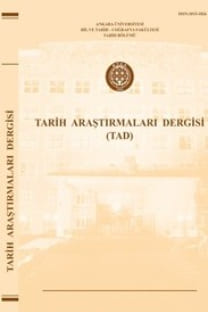Bizans Kisa Kroniklerinde Osmanli Algisi
Bizans Kısa Kronikleri olarak bilinen anonim kronikler, Osmanlı tarihçilerine 17.yy’a kadar uzanan olaylar hakkında zengin ve eşsiz bilgiler sunar. Bizans kaynakları içinde kendine özgü özellikleri nedeniyle daha çok Bizans’ın “gayriresmi tarihyazımı” örnekleri sayılan kroniklerin büyük bölümü Bizans taşrasındaki manastırlarda yazılmıştır. İstanbul’un fethinden sonra da bir bölümü Osmanlı egemenliği veya tehdidi altındaki eski Bizans taşrasında yazılan kroniklerde, 14.yy’dan itibaren Yunanca konuşan Ortodoks Hristiyan toplumunun Osmanlılar hakkında kullandıkları terminoloji ve ifadelere sıklıkla rastlıyoruz. Bu çalışma, kronik yazarlarının kullandığı terminoloji ve ifadeleri üzerinden söz konusu toplumun Osmanlılara yaklaşımını ortaya çıkarmayı amaçlamaktadır
Anahtar Kelimeler:
Bizans Kısa Kronikleri, Bizans Tarihyazımı, Osmanlı Algısı
Ottoman Perception in The Byzantine Short Chronicles
Anonymous chronicles, usually known as the Byzantine Short Chronicles, provide scholars of Ottoman history with rich and unique information about historical events having taken place until the 17th century. Majority of these chronicles, usually regarded as a part of “non-official historiography” due to their idiosyncratic features, were produced in rural monasteries of the Byzantine Empire. Even after the fall of Constantinople, these chronicles, which continued to emerge in the peripheries under the Ottoman domination or threat, provide an invaluable arena for examining Byzantine and post-Byzantine Orthodox Christian subjects’ visions of the Ottomans. The present study aims to explore the approaches of Byzantine authors toward Ottomans by focusing on the language and the vocabulary used for describing Ottomans
___
- BEIHAMMER, Alexander, “Orthodoxy and Religious Antagonism in Byzantine Perceptions of the Seljuk Turks (Eleventh and Twelfth Centuries)”, Al-Masaq: Islam and the Medieval Mediterranean, 23:1 (2011), 15-36.
- DURAK, Koray, “Defining the ‘Turk’: Mechanisms of Establishing Contemporary Meaning in the Archaizing Language of Byzantines, Jahrbuch der Österreichischen Byzantinistik, 59. Band/2009, 65-78.
- GREGORY, Timothy, Bizans Tarihi, çev. Esra Ermert, İstanbul 2008, s. 21
- KARPOZILOS, Apostolos, “Peter Schreiner, Die Byzantinischen Kleinchroniken. 2. Teil Historischer Commentar. 3. Teil Teilübersetzungen, Addenda et Corrigenda, Indices [Corpus Fontium Historiae Byzantinae. 12,2-12,3. Series Vindobonensis. ed. H. Hunger]. Wien, Öster. Akad. d Wiss. 1977, 644 S/1979/, 254 S.”, Ελληνικά (Hellenika) 34 (1982), p. 437.
- KALDELLIS, Anthony, Hellenism in Byzantium. The Transformation of Greek Identity and the Reception of the Classical Tradition,Cambride University Press, New York 2007
- KODER, Johannes, ““Romaioi and Teukroi, Hellenes and Barbaroi, Europe and Asia: Mehmed the Conqueror Kayser-i Rum and Sultan al-barrayn wa-l- bahrayn”-Summary. http://athensdialogues.chs.harvard.edu/cgibin/WebObjects/athensdialogues.woa/ wa/dist?dis=21.(13.11.2012). Athens Dialogues. 2010.
- KORAC, Dusan - Radič Radivoj, “Mehmed II, ‘the Conqueror’ in Byzantine Short Chronicles and Old Serbian Annals, Inscriptions, and Genealogies”, Zbornik Radova Vizantoloshkog Instituta (ZRVI) XLV (2008), s. 289-300.
- MANGO, Cyril, Bizans, Yeni Roma İmparatorluğu, çev. Gül Çağalı Güven, YKY, İstanbul 2007
- MORAVCSIK, Gyula, Byzantinoturcica, c. I-II, Berlin 1958.
- MOUSTAKAS, Konstantinos, “Byzantine ‘Visions’ of the Ottoman Empire: Theories of Ottoman Legitimacy by Byzantine Scholars after the Fall of Constantinople”, Images of the Byzantine World, Visions, Messages and Meanings Studies Presented to Leslie Brubaker, ed. Angeliki Lymberopoulou, Ashgate, 2011, s. 215-229.
- NICOLOUDIS Nicolaos, Laonikos Chalkokondyles, A Translations and Commentary of the ‘Demonstrations of Histories (Books I-III), Athens, 1996, s. 57-64.
- PAGE, Gill, Being Byzantine, Greek Identity Before the Ottomans 1200-1420, Cambridge University Press, Cambridge 2008, s. 170-176.
- REINERT, Steven W., “Mehmed II” Oxford Dictioanry of Byzantium, ed. A. Kazhdan, New York-Oxford 1991.
- SAVVIDES, Aleksios G. C., “Some Notes on the Terms Agarenoi, İsmailitai and Sarakenoi in Byzantine Sources”, Byzantion 67 (1997), 89-96.
- SCHREINER, Peter, “Zur Bezeichung ‘Megas’ und ‘Megas Basileus’ in der byzantinischen Kaisertitulatur” Byzantina (3), 1971, s. 175-192.
- ----------------, Peter, Die Byzantinischen Kleinchroniken, I-III, [Corpus Fontium Historiae Byzantinae 12/1-3], Wien, 1975-1979.
- ----------------, Peter, Studien zu den Βραχέα Χρονικά, Miscellanea Byzantina Monacensia 6, München 1967, s. 116-119.
- TODOROVA, Maria, Imagining the Balkans, Oxford University Press, New York 1997, p. 167-168.
- TODOROVA, Olga, “The Ottoman State and its Orthodox Christian subjects: the legimistic discourse in the seventeenth-century ‘Chronicle of Serres’ in a new perspective”, Turkish Historical Review, I (2010), 86-110.
- VAKALOPOULOS, Apostolos, Ίστορία τοῦ Νέου Έλληνισμοῦ, c. Ι, Thessalonike 1974.
- WITTEK, Paul, “Der ‘Beiname’ des osmanischen Sultans Mehemmed I”, Eretz- Israel 7 (1964), s. 144-157.
- ZACHARIADOU, Elizabeth, “Suleiman Çelebi in Rumili and the Ottoman Chronicles” Der Islam, 60.2 (1983), 268-290.
- ISSN: 1015-1826
- Yayın Aralığı: Yılda 2 Sayı
- Başlangıç: 1963
- Yayıncı: Levent KAYAPINAR
Sayıdaki Diğer Makaleler
Harb-i Umûmî’de Osmanlı Devleti’nin İran Cephesi’nde yaşadığı bazı istihbarat zaafları
Mehmet Zahit YILDIRIM, Osmanlı Devleti’nde Jurnal Teşkilatı (1835-1860)
Memlûklerde meşrûiyet arayışları ve saltanat inşasına yönelik çabalar “sultanı öldüren sultan olur”
Refik Halit Karay, Kirpi’nin dedikleri
A.C.S. Peacock, Early Seljuq History
Ottoman perception in the Byzantine Short Chronicles
Cumhuriyet döneminde Türkiye’de yol vergisi
Memlûklerde Meşrûiyet arayışları ve saltanat inşasına yönelik çabalar Sultanı öldüren Sultan olur
